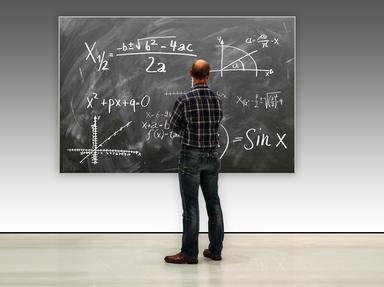Quiz Answer Key and Fun Facts
1. In classical physics, waves are represented as vibrations in a medium. In the late 19th century light and other electromagnetic waves were assumed to move through the luminiferous ether. According to Maxwell's theories on wave propagation, how did the direction of the vibration of electromagnetic waves relate to the direction in which electromagnetic waves were moving?
2. In the late 19th century Michelson and Morley's experiment did not detect the presence of an ether wind. Additionally, James Clerk Maxwell devised equations that successfully described electromagnetic waves, but the equations predicted that observers traveling different speeds relative to one another would "see" a particular electromagnetic wave differently. Hedrick Lorentz devised equations that would account for both the absence of the ether wind and the peculiar predictions of Maxwell's equations. What made Lorentz's equations unsatisfying, even to Lorentz?
3. Despite the implications of Einstein's special theory of relativity, research into the nature of the medium in which electromagnetic waves traveled continued. What did Einstein claim his theory implied regarding this medium?
4. Einstein's theory of relativity deals with the behavior of matter moving at speeds approaching the speed of light relative to an observer. Two men in separate space ships, each holding a meter ruler and a clock, pass each other at 99% of the speed of light. Based on the equations of Hedrick Lorentz (the Lorentz transformations), what will the two men observe?
5. In light of the fact that measurements of length, time and mass seemed dependent on the relative speeds (the inertial reference frame) of observers, Einstein pondered what was constant relative to all reference frames. The theory of relativity arises from the assumption that which two things are constant to observers in all reference frames, independent of their relative speeds?
6. What was Einstein's original choice for a name for his theory?
7. Lorentz transformations correct for the relative speed of different observers using an expression equal to one divided by the square root of the quantity (1 minus v squared divided by c squared), where "v "is the relative velocity and "c" is the speed of light. This expression is called the "gamma". Therefore, as one moves faster, gamma becomes larger. As an object moves faster relative to an observer, the mass of the object increases to the observer. In order to obtain the corrected mass should one multiply or divide the mass by the "gamma"?
8. A particle is accelerated to 90% of the speed of light in a particle accelerator. If it is a short-lived particle at rest, will a shortened or lengthened half-life be observed?
9. The theory of relativity allows us to calculate the amount of energy, "E", that would be released if a mass of "m" were converted to energy. The famous equation expressing this is which of the following?
10. Which of the following best describes Einstein's general theory of relativity?
Source: Author
uglybird
This quiz was reviewed by FunTrivia editor
crisw before going online.
Any errors found in FunTrivia content are routinely corrected through our feedback system.

